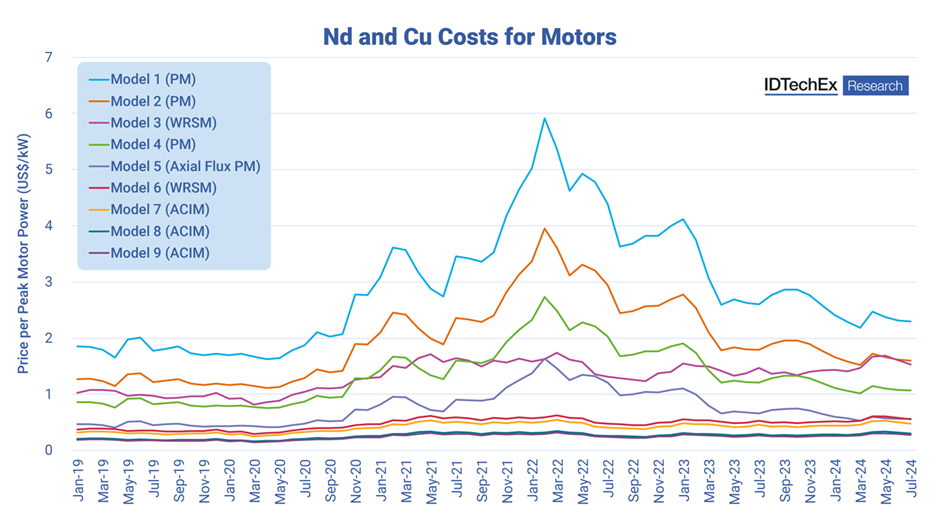
Electric vehicles continue to be a focal point of innovation, as researchers and engineers work to improve designs, to get around to get around drawbacks such their heavy weight and lower the cost of manufacturing them.
Improved battery designs is what we hear a great deal about. The development of structural batteries promise substantially lower weight for EVs, which in turn will increase their range as less energy is required for propulsion. Toyota is one car maker that is working on improving battery technology so that by 2026, full-electric EVs will have 1000 kilometre cruising range.
Despite the extended range the next-generation performance batteries will be faster to charge, cheaper and be combined with further efficiencies in car aerodynamics and weight reduction. Toyota is also looking at bipolar lithium-ion high performance batteries for 2027-28. That's also when the Holy Grail of battery technology that uses solid electrolytes is expected to enter mass production.

Electric vehicle pioneer Nissan said it too is developing solid state batteries. China's giant battery tech corporations BYD and CATL have thrown their hats into that ring, and Nio appears to have a vehicle with 150 kWh solid state battery ready to roll already. SAIC's MG brand is supposed release a solid-state battery EV in the second half of next year. Samsung's putting silver into batteries which apparently works great.
Not to be outdone, Mercedes-Benz is investing in United States battery maker Factorial, which reckons it'll produce high-energy density storage units for EVs for the next decade. This is not a complete summary and it's fair to say there's quite a bit going on in BatteryTech-land.
Get your EV motor running
There's more that can be done to improve EVs though, and Cambridge-based market intelligence firm IDTechEx has looked at the motors they use. Its report, Electric motors for electric vehicles 2025-2035: technologies, materials, markets and forecasts makes for fascinating rabbit hole to go into.
One issue is the use rare-earth elements (they're not actually rare) for permanent magnets in electric motors. Abbreviated as REEs, they are mainly produced in China, and European car makers and Tesla are trying to figure out how to use alternative electric motor designs for that reason.

IDTechEx noted that permanent magnets made with REEs are expensive. They often take up around a third of a motor's bill of materials, despite only forming a relatively small part of the unit.
A problem here is that wound-rotor synchronous motors that don't use magnets are expensive to make due to copper windings, and aren't as efficient.
Swapping out REEs for other materials such as ferrites and aluminium-nickel-cobalt (AlNiCo) works, but requires more magnetic material as they don't provide the same level of performance.
Efficiency is a key factor to reducing EV costs, IDTechEx said. Even a small increase in efficiency can make a fairly large difference. IDTech calculated that if a motor has 96 per cent efficiency instead of 93 per cent, it would lower the energy needed for a 75 kWh vehicle by roughly 2.9 per cent for the same range. That would reduce the battery cost by the same amount. Based on a battery cost of US$100 per kWh, it could save US$200.
How many motors will be needed for the EV market in 2035? IDTechEx reckons over 160 million, with 30 per cent using REE-free technologies.
Pancake motors to the rescue
There's more than one way to propel an EV, and IDTechEx mentions axial flux motors. That name might evoke the very cool Æon Flux sci-fi for some of us, but it refers to electric motors where the gap between the rotor and stator is aligned parallel with the axis of rotation.
More commonly used radial flux motors, as the name implies, align the gap radially with the axis of rotation.
What buys is some fascinating advantages, like torque increasing by the cube of rotor diameter whereas radial axis motor twist only rises by the square.
Motors can also be flat, much lighter in weight, and the copper windings for them can be simpler, and there's a greater area for cooling. Axial flux motors have been made for aircraft, and for marine electrification.
A company owned by Mercedes-Benz, the amazingly named Yokeless and Segmented Armature (YASA) is working on an engine that weighs 7 kilograms and which produces 220 kW, or 31 kW per kg.
YASA motors are used in production supercars like the hybrid Ferrari SF90 and 296GTB, and the Lamborghini Revuelto, more for the sake of augmenting power than saving on fossil fuel (the Lambo has V12 as well as electric motors.)
For more real-world applications of axial flux motors, there's China's state-owned Dongfeng Corporation's ProteanDrive. Dongfeng has two types of motors, the Pd18 and Pd16, which produce a huge amount of torque at 1500 Newtonmetres and 800 Nm respectively.
ProteanDrive motors can be built into the wheels of cars, buses (like Olli the autonomous public transport vehicle in Glenelg, South Australia) and lorries.
And look; they can be used to convert true and tested cars like the Land Rover Defender to EV technology:
Vehicles built that way have no drive shafts, gears, differentials etc to worry about, as the motors are mounted into the wheels. Which Dongfeng has done, with its E70 and the luxe Voyah ZhuiGuang (something to do with chasing light?). The motors are lightweight, remember.
Axial flux motors aren't new as such, and they are commercially produced albeit not at the scale of radial flux ones. There's Agni Motors, which is using a pancake axial flux design by Cedric Lynch which among other applications have been used in zero-emission racing motorbikes.
The ability to come up with new and completely different vehicle designs is an important advantage that EVs bring to the table, and which is often overlooked.
29 Comments
A 7 kg motor which produces 220 kW... wow ... even Greta would want one of those ... how amazingly quickly the technology in this space has progressed and developed ... Impressed !
Fascinating article thanks Juha.
These new motor designs will revolutionize transport and industry.
Bye bye hydraulics and pnuematics , in many applications. i think air tools have already been superseded by brushless motors in al lot of applications already.
When we bought our current property one of the first things I meant to buy was a shop-size air compressor to replace the one taken out by the previous owner. Five years later all the air lines in the workshop are still there, still unused. I have a cheap compressor for things like inflating tyres but with the progress in battery tools since then I haven't yet found the need to run a comprehensive air setup.
Maybe if I ever get around to painting vehicles I'll consider it but when my battery impact wrench can undo Honda crank bolts (widely known as the toughest fixing in the world to crack) and my grinder can run all day on a single charge then I'll use the extra money and floorspace for another rack of tool skins.
Yes, I haven't put compressed airlines in my new workshop, and doubt I'll bother. Used the portable for air dusting, or blowing up truck tires, maybe 3 times in the last year.
Now I'm looking at my tired old digger, and thinking it will be cheaper to add electric assisting motors than rebuild the hydraulics.
The ability to come up with new and completely different vehicle designs is an important advantage that EVs bring to the table, and which is often overlooked.
This can already be done. Concepts like the Citroen Oli is where EVs should have gone, lightweight vehicles with novel design, making for less resource intensive cars with lower battery requirements.
Unfortunately fashion has dictated very heavy, luxurious EVs are the most marketable/viable, so instead we have the current crop which are much more like an FF vehicle, with all the inefficiencies of higher curb weights and larger batteries (and pricetags).
Still, I like the idea of much smaller motor sizes and potential retrofit capabilities.
You have pedestrian impact standards to thank for that.
Also, all cars should look like the XJ220, I'm pretty sure that's scientific fact or something.
Agreed though, the retropower potential for small motors and batteries is nuts. A classic Mini with a 400km range and near-WRC acceleration would find a home in my garage very quickly.
They did end up producing the Ami though. In theory, makes the most sense for an electric vehicle; under half a tonne, 75k range, cheap.
Instead, the market demands a couple of tonnes, many multiples more battery, and considerably more cost.
Smart did an electric version of the ForTwo range.
Their 415ED model does 100km on a charge and weighs under 1,000kg (unlaiden). Only two seats and a harsh ride though. It would be so very suitable for so many people but was too expensive when new (plus the lack of seats and harsh ride previously mentioned). Looks a bit dorky too.
I disagree.
They should look like the XJR-15.
You're both wrong.
Original Ford GT40.
I'm willing to soften my position. How about this: As long as they look like any top level GT racer that is 30 or more years old that none of us will ever be able afford, then the world could have a much brighter future after all.
Just not a Consulier GTP. I would rather welcome the heat death of the universe.
Sounds good.
The kids can stay at home.
I'm not prepared to accept I'm wrong but I will accept that I could have been more right.
Not sure Smith & Smith carry the front windscreen in their regular inventory but I'm sure they'll meet the market.
Good thing a classic mini is front wheel drive, otherwise you'd risk torque flipping onto the roof.
I do wonder what all that torque in a hub motor motorbike would feel like. Used to have a shaft drive, the back would climb up if you powered on coming out of a corner. A bit unnerving, but you got used to it. Maybe why they never used shaft drive in racing bikes.apart from power loss.
If those motors end up flat enough, I can slot one under the passenger seat and get the Group B Mini we should have gotten, instead of the Frankenstein 6R4.
What happens to the online trolls when oil is $5/L and EVs can drive for a week on a single charge?
Where will they go? Who will lead them?
Then the advantages are undisputably apparent and the discussion doesn't need to be so tribal.
Yes. At the moment there are pros and cons for each. Different things suit different people. eg No parking/charging at your house, chargers vandalized, chargers hogged, heavy vehicles vs petrol cost, pollution, maintenance etc etc
Most people would have an open mind.
I'll switch the moment it stacks up, financially and practically.
I'm also accepting my use case isn't universal.
Where will they go? Probably the same place as the EV owners... ie nowhere
If Oil spikes too high you wont have much of an electrical grid or road or industry for long
True, people tend to think buying an EV somehow makes you immune to the realities of a wider world still dependent on FF usage.
I can get me an electric farm implement capable of an hour or so operation at a time. Depending on the time of year, I need to use one all day.
That will improve, and they already have trailer size rapid chargers they move around construction sites to recharge machinery.
But hybrid would probably be the best solution to most farm applications. Smaller ice motor running continuously full bore, with batteries smoothing out the peaks.
What's the game changer - one charge that lasts a minimum 800 kilometres for at least 200 cycle repeats. That might end my internal debate.
There will still be cyclists and speed bumps to foam about.
Is this the same is the axial motor in my bathroom extractor fan?
I think another advantage is it is easier to vary the gap between the electrical field and the magnetic field.
But I haven't gone there since polytechnic, where the tutor would stand in front of the class, and make weird movements with his thumb and hand, to explain the flux field.

We welcome your comments below. If you are not already registered, please register to comment
Remember we welcome robust, respectful and insightful debate. We don't welcome abusive or defamatory comments and will de-register those repeatedly making such comments. Our current comment policy is here.